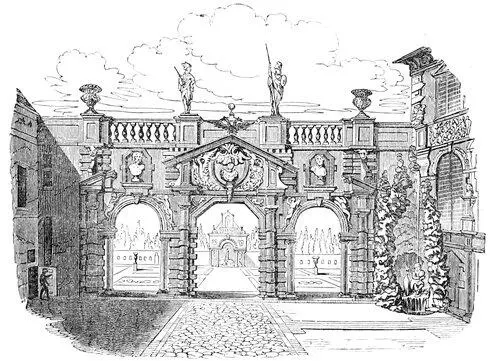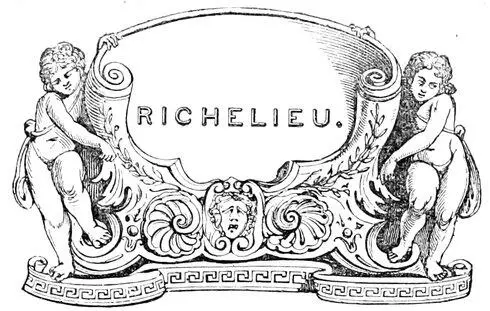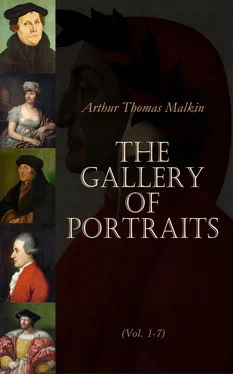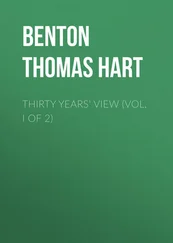Rubens returned to Flanders in 1627, and had no sooner rendered an account of his mission to the Infanta, than he was sent by that princess to England in order to sound the Government on the subject of a peace with Spain, the chief obstacle to which had been removed by the death of the Duke of Buckingham. It is probable that Rubens’s extraordinary powers as an artist formed one motive for employing him in those diplomatic functions. The monarchs to whose courts he was sent were passionate admirers of art; and the frequent visits which they made to Rubens in his painting room, and the confidence with which they honoured him, gave him opportunities, perhaps, in his double capacity, of obviating political difficulties, which might not otherwise have been so easily overcome. This was certainly the case in his negotiations with Charles I. He was not, it appears, formally presented in the character of an envoy. But the monarch received him with all the consideration due to his distinguished character; and it was while he was engaged on the paintings at Whitehall, the progress of which the King delighted to inspect, that he disclosed the object of his visit, and produced his credentials. This he did with infinite delicacy and address; and the King was by no means indisposed to listen to his proposals. A council was appointed to negotiate with him on the subject of a pacification, which was soon after concluded. It was on this occasion that Rubens painted and presented to the King the picture of Peace and War, which is now in our National Gallery. The relation of that work to the object of his mission is obvious: the blessings of peace in contradistinction to the miseries of war are beautifully illustrated; and whether Rubens paid this compliment to the King while his negotiations were in progress, or after they were terminated, a more elegant and appropriate gift was never addressed by a minister to a monarch. The painter was splendidly remunerated, and honoured with knighthood by Charles in 1630. The object of his mission being happily accomplished, he returned to the Netherlands, where he was received with the distinction due to his splendid genius and successful services.
His various and incessant labours appear to have prematurely broken his constitution; he had scarcely attained his fifty-eighth year when he was attacked by gout with more than usual severity. This painful disease was succeeded by a general debility, which obliged him to desist from the execution of large works, to relinquish all public business, and even to limit his correspondence to his particular friends, and a few distinguished artists. His letters, however, when he touches on the subject of art, rise into a strain of animated enthusiasm. He continued to work, but chiefly on small subjects, till the year 1640, when he died at the age of sixty-three. He was interred with great splendour in the church of St. James, under the altar of his private chapel, which he had ornamented with one of his finest pictures. A monument was erected to his memory by his widow and children, with an epitaph descriptive of his distinguished talents, the functions he had filled, and the honours with which he had been rewarded.
In extent of range the pencil of Rubens is unrivalled. History, portrait, landscape under the aspect of every season, animal life in every form, are equally familiar to him. His hunting pieces especially, wherein lions, tigers, and other wild animals, with men, dogs, and horses, are depicted under all the circumstances of fierce excitement, momentary action, and complicated foreshortenings, are wonderful. Rubens wanted only a purer style in designing the human figure, to have been a perfect, as well as a universal painter. His taste in this particular is singularly unlike that which the habits of his life seemed likely to produce. He had been bred up in scenes of courtly elegance, and he was acquainted with whatever was beautiful in art; yet his conception of character, especially in relation to feminine beauty, betrays a singular want of refinement. His goddesses, nymphs, and heroines are usually fat, middle-aged ladies, sometimes even old and ugly; and they always retain the peculiarities of individual models. His men too, though not without an air of portly grandeur, want mental dignity. Faults of such magnitude would have ruined the fame of almost any other painter; but while the pictures of Rubens are before us, it is hard to criticise severely their defects. If, as a colourist, he is inferior to Titian, it is, perhaps, rather in kind than in degree: Titian’s colouring may be compared to the splendour of the summer sun; that of Rubens excites the exhilarating sensations of a spring morning. It is true that the artifice of his system is sometimes too apparent, whereas, in Titian, it is wholly concealed; Rubens, however, painted for a darker atmosphere, and adapted the effect of his pictures to the light in which they were likely to be seen. Inferior to Raphael in elegance and purity of composition, he competes with him in fertility and clearness of arrangement. He drew from Paul Veronese a general idea of diffused and splendid effect, but he superadded powers of pathos and expression, to which that artist was a stranger. It is, as Reynolds justly observes, only in his large works that the genius of Rubens is fully developed; in these he appears as the Homer of his art, dazzling and astonishing with poetic conception, with grandeur, and energy, and executive power.
Of Rubens’s personal character we may speak in terms of high praise. He bore his great reputation without pride or presumption; he was amiable in his domestic relations, courteous and affable to all. He was the liberal encourager of merit, especially in his own art, and he repaid those among his contemporaries who aspersed him, by endeavouring to serve them. His own mind was uncontaminated by envy, for which perhaps little credit will be given him, conscious, as he must have been, of his own most extraordinary endowments. His noble admission, however, of Titian’s superiority, when he copied one of his works at Madrid, attests the magnanimity of his disposition; and his almost parental kindness to his pupil, Vandyke, shows that he was equally willing to recognize the claims, and to promote the success of living genius.
Rubens’s greatest works are at Antwerp, Cologne, Paris, Munich, and Madrid. The paintings at Whitehall might have formed a noble monument of his powers, but they have suffered both from neglect and reparation. There are smaller works of his in the National Gallery, the Dulwich Gallery, and in almost every private collection in this country.
The best memoir of Rubens with which we are acquainted is in La Vie des Peintres Flamands, par Descamps. Notices may also be found in the Abrégé de la Vie des Peintres, par De Piles. There is an English life in Bryan’s Dictionary of Painters.

Entrance to Rubens’ Garden, from a design by himself.

Engraved by T. Woolnoth. RICHELIEU. From a Picture, in his Majesty’s Collection. Under the Superintendance of the Society for the Diffusion of Useful Knowledge. London, Published by Charles Knight, Pall Mall East.

Table of Contents
The name of Du Plessis was borne by an ancient family of Poitou, which subsequently acquired by marriage the property and title of Richelieu. Francois Du Plessis was attached to King Henry III. while he was yet Duke of Anjou; accompanied him when he became King of Poland; and was made Grand Provost of his Court, after his accession to the throne of France. In this capacity he arrested the followers of Guise, when that duke was assassinated at Blois, in 1588.
Читать дальше















